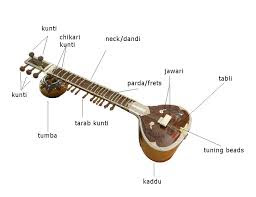Sitar | Indian Classical Music Instrument
Origin of Sitar
There are many stories about the development of the sitar. The most common story is that Amir Khusru, a great personality during the reign of Allaudin Khilji around 1300 AD is the inventor of the sitar though it has no historical base. But it is clear that Sitar evolved from the Persian lutes that had been played in the Mogul courts for hundreds of years.
Another theory states that in the 18th century by another Amir Khusru who was the 15th descendent of Naubat Khan, the son-in-law of Tansen; developed this instrument from the Persian sehtar.
After that, Amir Khusru's grandson; Masit Khan keep on developing this sitar. He composed many "slow gats" in the dhrupad style of the day which is known as Masitkhani Gat.
Raza Khan, also a descendent of Tansen took important roll in the development of sitar. He created the "fast gat" which is known as Razakani gat.
The sitar is one of the most well known classical Indian instrument. Sitar may be called a part of the lute family of stringed instruments. The sitar has a long, broad, fretted neck and a gourd-shaped body.
The sitar has 7 strings, 11-13 resonating strings and 20 frets.
 |
| Different parts of Sitar |
The sitar has two bridges. One is called bada goraj or main bridge and another is chota goraj or secondary bridge. During playing the string reverberates and as its edge touches the bridge creates overtones and lends it a distinct, rich tone. Proper adjustment of the jawari promotes this fullness of sound. The mazrab, is used by the player's dominant hand to pluck the sitar. The thumb of the playing hand should be positioned on the top of the fret board just above the main gourd.
Famous Sitar Player
Pandit Ravi Shankar, Pandit Nikhil Banerjee, Ustad Vilayat Khan, Annapurna Devi, Anoushka Shankar are some of the best Indian sitarist




0 Comments